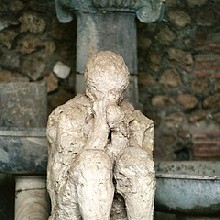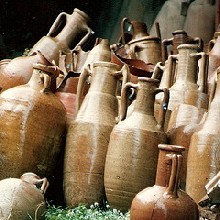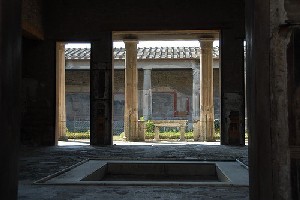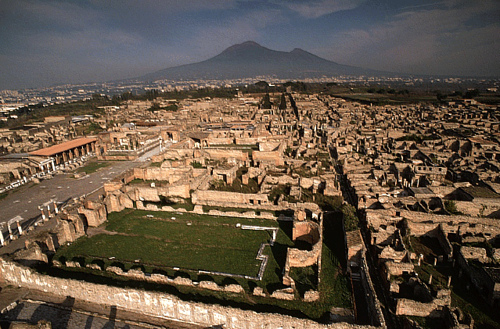
The Vesuvio eruption that destroyed Pompeii took place in 79 AD.
In the year 62 AD. Pompeii was severely damaged from an earthquake. And in 79 the city was still not fully rebuilt. At that time – especially in summer – about 15,000 – 20,000 people lived in the town. 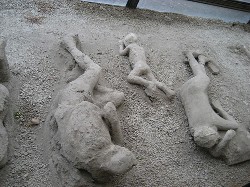 The remains of just over 1000 people has been found, consisting of slaves, sick people, pregnant women, elderly and family members who do not simply want to leave their houses.
The remains of just over 1000 people has been found, consisting of slaves, sick people, pregnant women, elderly and family members who do not simply want to leave their houses.
The high gas content in the magma eruptions also run extremely explosive.
A massive detonation happened at noon on August the 24th and huge masses of rock fell from an altitude of more than 30 kilometres. The wind drove down the falling pumice stones and others towards Pompeii. Under this load the roofs of houses collapsed. The remaining residents and the refugees protect themselves with pillows over their heads against this stone rain.
The devastating volcanic eruption ended only after 18 hours, with its ash cloud that changed the day into night illuminated only by the glow of the fire. At the same time, there were minor earthquakes and tsunami, which, with its tidal waves, made impossible the escape through the sea.
Even the heat that scorched the pulmonary vesicles, was deadly and the dust and toxic gases led to asphyxiation.
The city was not only completely buried in volcanic ash, but also the eruption led Pompeii far from the sea where it is situated nowadays.
It was excavated since 1738 under Charles of Bourbon, and the excavation became systematic from 1869. Thanks to the preservation of volcanic ash the excavations now offer a unique and largely complete snapshot of that time with shops, restaurants, bakeries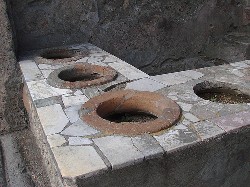 , etc., so that even as a visitor someone can get a vivid impression in the daily life of an ancient Roman city.
, etc., so that even as a visitor someone can get a vivid impression in the daily life of an ancient Roman city.
Pompeii is the main tourist destination in the entire region. If a visitor is non well prepared about its history and culture, it seems better to join one of the paid tours to walk through it.
It is very easy to reach even without car. Near the entrance to the excavation site by the “Porta Marina” there is the station “Pompei-Scavi” the (private) Circumvesuviana line Naples-Sorrento. Also from the railway station of the state (for example from the area around Paestum) visitors can in a few minutes walk to the excavation site.
Entrance are located in:
Porta Marina – Piazza Anfiteatro and Piazza Esedra
Opening Time:
from 1st November to 31st March: daily from 8.30 to 17.00 (last admission 15.30)
from 1st April to 31st October: daily from 8.30 to 19.30 (last admission 18.00)
Closed: 1st January, 1st May, 25th December.
Tickets:
Single (valid for 1 day):
Full € 11,00
Reduced € 5.50
With access to 5 sites (Pompeii, Herculaneum, Oplonti, Stabia, Boscoreale) – (valid for 3 days)
Full price: € 20.00
Reduced: € 10.00
Visitors are called to observe the following rules:
•Do not stop on the brink of the excavation or climb on walls
•Observe a respectful behaviour;
•Do not write on the walls;
•Put waste in proper containers;
•Photographs and films are allowed only for private use; for shooting with tripods, flash lights or for commercial use, visitors must contact the offices of the Sopraintendenza.
•Deposit bags, backpacks, umbrellas and other bulky items in the wardrobe;
•Smoking is not allowed;
•Animals are not admitted;
•They advice of the possible presence of stray dogs which have passed the defence perimeter of the excavations. It is recommended to keep distance and be careful.
Click here for more information about facilities to vist Pompeii and Campania
